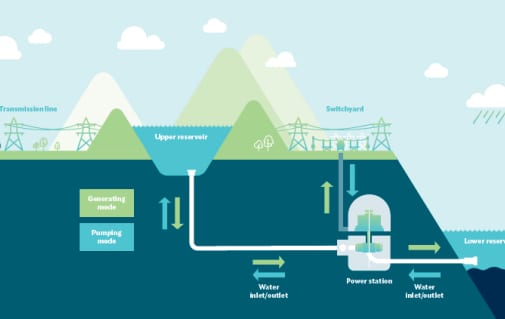Tasmania’s bid to be the “battery of the nation” has gained new momentum this week, with fresh estimates that Australia’s island state could provide just under 5GW of storage capacity from just over a dozen of its best pumped hydro sites.
HydroTasmania said on Wednesday that 14 “high potential” pumped hydro sites had been narrowed down from a shortlist of 30 that resulted from an assessment of around 2,000 sites in the state – a project backed by an ARENA grant of $2.5 million. (See table below – a bigger, more detailed table is included at the end of the story.)
Those 14 sites, located around eight existing reservoirs across Tasmania’s central highlands, north and west coasts, represented a combined capacity of up to 4,800MW of storage capacity, HydroTas and ARENA said in jointly released statements.
That impressive capacity, at nearly twice the amount the feasibility study had expected to find back in September, bodes well for Tasmania’s bid to become the Battery of the Nation – providing flexible, dispatchable energy when needed, both in the state and on the mainland.
It is also drawing inevitable comparisons with the federal government’s pet renewables project, Snowy 2.0, which will deliver less than half the capacity and has been estimated to cost up to $4.5 billion, or $2.25 million per MW.
By contrast ARENA says Tasmania’s pumped hydro capacity, which is expected to be refined down further by HydroTas to a total of 2500MW of high potential sites, has an estimated total capital cost of $1.1 – $2.34 million per MW.
According to Hydro Tasmania, most of the sites have an estimated cost of between $1.05 million and $1.5 million per MW to build.
“Two things are now official: Battery of the Nation stacks up very well; and we can deliver it,” said Hydro Tasmania CEO Steve Davy in comments on Wednesday.
“Battery of the Nation is about locking in our island’s energy security and giving Tasmanians the lowest possible power prices. It offers a future that’s clean, reliable and affordable.
“Doubling Tasmania’s clean energy would also create a surplus, beyond our own needs, to support mainland Australia. That’s crucial to replace the coal power that’s being phased out,” Davy said.
But the report also notes that fully unlocking Tasmania’s pumped hydro potential will need “additional interconnection” with mainland Australia, beyond the existing Basslink cable, which returned to service this week after a 10-week outage.
HydroTasmania said that TasNetworks was currently assessing the business case for a second interconnector with the support of ARENA.
“As Australia’s renewable energy make-up continues to grow, energy storage will be increasingly necessary, which is why this project is so important,” said ARENA CEO Ivor Frischknecht.
“Tasmania has been identified as the Battery of the Nation for a reason, as it has some of the best wind resources and existing hydro-electric power.
“Unlocking most of these opportunities requires additional interconnection, which is why ARENA is also working with TasNetworks to assess the feasibility of a second interconnector,” he said.
Hydro Tasmania says it will now investigate the 14 options in detail, and narrow them down to a smaller number of sites, equivalent to about 2500MW of pumped hydro potential.











